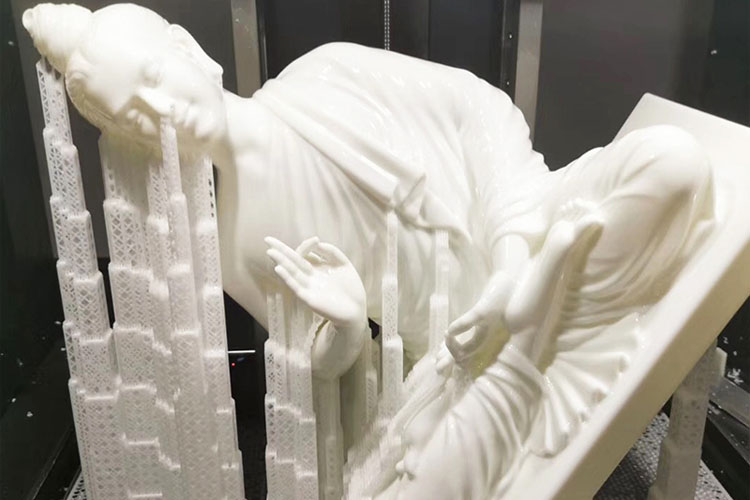The application of 3D printing in the FRP industry is mainly reflected in the production of FRP sculpture models. Through 3D printing technology, the efficiency of fiberglass sculpture production can be significantly improved, more complex designs can be achieved, and time and budget costs can be saved to a large extent.
Specifically, 3D printing technology can convert CAD model data into controllable 3D printer operating instructions, and create physical objects based on digital models through layer-by-layer deposition, melting, powder sintering, etc. In the production of fiberglass sculptures, you can use a 3D printer to quickly print out the model of the sculpture, and then use fiberglass materials for subsequent processing and production. This method can not only quickly complete model production, but also achieve various complex designs and shapes to meet the creative needs of sculpture artists. Below we will explain the application of
SLA 3D printers in the field of fiberglass sculptures.
The SLA 3D printing manufacturing process mainly includes the following steps:
1. Slice file generation: Import the designed 3D model into the slicing software and generate the slice file. During this process, parameters such as printing layer height and filling density can be adjusted.
2. Prepare materials: Load the photosensitive resin into the material tank of the SLA 3D printer.
3. Print the product: The printer will first print a bottom layer to fix the position of the model and ensure print quality.
4. Layer-by-layer printing: According to the instructions of the slicing file, the SLA 3D printer will solidify the photosensitive resin layer by layer and print the model layer by layer from bottom to top. A laser or beam shines on the photosensitive resin, curing it to form each layer of the model.
5. Complete printing: When all layers of the model have been printed, the printer will automatically stop. At this time, the printed object needs to be taken out of the light curing tank.
6. Subsequent processing: After removing the printed object, some subsequent processing operations may be required, such as removing support structures, surface treatment, etc., to achieve the final required quality and appearance.
The production speed of SLA 3D printer is about 100-400g/h. For example, the production speed of Harbin 3D H360 is 100-300g/h, and the production speed of HI-600 and HI-800 is 300-400g/h. Using light-curing resin for 3D printing can produce large-format sculptures in a shorter time, and the surface is very smooth and can be colored without much post-processing.
In contrast, the traditional FRP process requires the following steps:
1. Mold making: First, the corresponding mold needs to be made, usually made of wood boards, aluminum plates and other materials.
2. Prepare materials: Prepare fiberglass cloth, epoxy resin and other materials, and mix them according to the proportion.
3. Coat the mold: Coat the release agent on the surface of the mold, then place the prefabricated fiberglass cloth inside the mold, and evenly apply the epoxy resin with a brush or spray gun to penetrate into the fiber cloth.
4. Spreading: After the first layer of fiber cloth and epoxy resin are dry, add a second layer of fiber cloth and repeat the process of applying epoxy resin until the required thickness is reached.
5. Curing: After the spreading is completed, the mold is placed in a high-temperature oven for curing, which usually takes several hours to a day.
6. Demoulding and subsequent processing: After curing, take out the mold and demould. Finally, some subsequent processing operations may be required, such as polishing the surface.
Compared with traditional processes, SLA 3D printers have higher manufacturing efficiency and a more simplified process flow, which can meet customer needs faster and improve production efficiency.
There are obvious differences in the forming principles between SLA 3D printing and traditional FRP technology. The traditional FRP manufacturing process first involves making a simple mold and coating the mold with a release agent. After the mold is dry, the resin and glass-reinforced fibers are mixed and shaped by hand coating, followed by curing and demoulding, and finally post-processing. This process is relatively cumbersome, requires experienced masters to perform skilled operations, and takes a long time to produce. For SLA 3D printing, you only need to import the model into the slicing software, adjust the parameters and start printing. The slicing process usually only takes 10-20 minutes. The printing time depends on the model size, and the maximum production capacity can reach 400g/h.
In terms of material cost, the raw material cost of photosensitive resin is generally between tens of yuan and 200 yuan per kilogram, while the cost of fiberglass is about 800 yuan per square meter, and the cost of using SLA 3D printing is 200-400 yuan per square meter. about. Although the material costs are similar, FRP production requires higher labor costs because operators need extensive experience to perform manual operations, which will also affect the total cost of the product. In contrast, SLA 3D printing craftsmen only need 2-3 days of training to operate the printer.
In terms of product quality, the SLA 3D printing process is to solidify materials layer by layer. The surface details of the printed model are smooth and can be used after simple post-processing. However, traditional fiberglass manufacturing requires multiple manual coatings, trimming and polishing, which is prone to errors and unevenness and requires more manual processing. SLA 3D printers print by solidifying resin with laser, making products with higher strength and fineness. However, it should be noted that because the materials used are relatively fragile, the impact resistance of the product is not as good as traditional fiberglass products. Therefore, you can consider combining fiberglass materials to enhance the strength of the product.
In terms of manufacturing process, the traditional FRP process requires many steps such as manual mold making, resin coating, and fabric lamination, so the manufacturing cycle is long. SLA 3D printers use advanced 3D printing technology to produce parts by curing resin layer by layer, greatly shortening manufacturing time and reducing labor costs.
The problem that customers may mention is that they want to replace the foam molding process with SLA 3D printing + fiberglass. Although this is not very difficult, you may encounter problems caused by the new process. However, there are already relatively mature process cases for reference, so potential problems can be solved through preliminary research and practice. As for the sculpture or architectural decoration industry, choosing to use SLA 3D printing to make models can make products more efficiently and at a lower cost. Currently, there are not many uses on the market, and it is still a blue ocean market.
In addition, 3D printing technology can also be used to produce various practical fiberglass products, such as lamps, household items, etc. Through 3D printing technology, fiberglass products with unique shapes and complex structures can be produced, bringing more space for innovation and imagination to people's lives. In short, the application of 3D printing technology in the FRP industry has broad prospects and potential, and can bring more innovation and possibilities to the design and manufacturing of FRP products.



